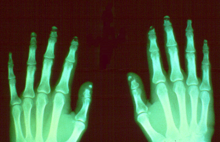Acroosteolysis

Acroosteolysis is resorption of the
phalanges. Acroosteolysis has two patterns of resorption in adults
: diffuse and bandlike.
The diffuse pattern of resorption has a widely diverse
Raynaud's neuropathy, trauma, epidermolysis bullosa, psoriasis, frostbite, sarcoidosis, hypertrophic osteoarthropathy, acromegaly, and advanced leprosy.[1][2][3]
The bandlike pattern of resorption may be seen with
Hadju-Cheney syndrome.[1]
A mnemonic commonly used for acro-osteolysis is PINCHFO.[4] Pyknodysostosis, Psoriasis, Injury (thermal burn, frostbite), Neuropathy (diabetes), Collagen vascular disease (scleroderma, Raynaud's), Hyperparathyroidism, Familial (Hadju-Cheney, progeria), Occupational (polyvinyl exposure),
Acroosteolysis may be associated with minimal skin changes or with
: 665See also
References
- ^ a b Yu, Joseph. Musculoskeletal Imaging, Case Review Series. 2008.
- ^ Romero, Belinchón; Ramos Rincón, J.M.; Reyes Rabellc, F. "Nail Involvement in Leprosy". ACTAS Dermo-Sifiliograficas. Academia Española de Dermatología y Veneralogía. Archived from the original on 28 April 2015. Retrieved 28 June 2014.
- ISBN 978-0470657355. Retrieved 28 June 2014.
- .
- ISBN 0-07-138076-0.
